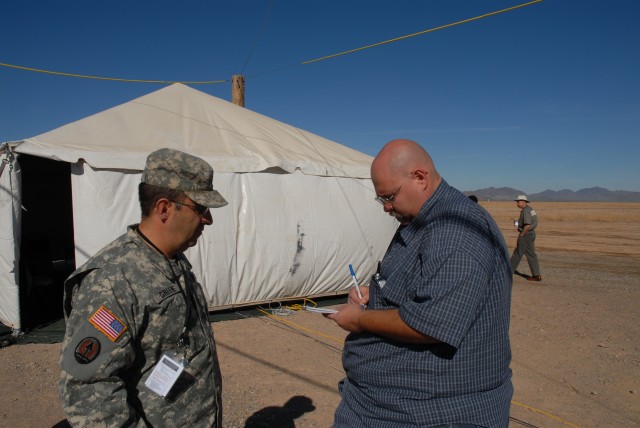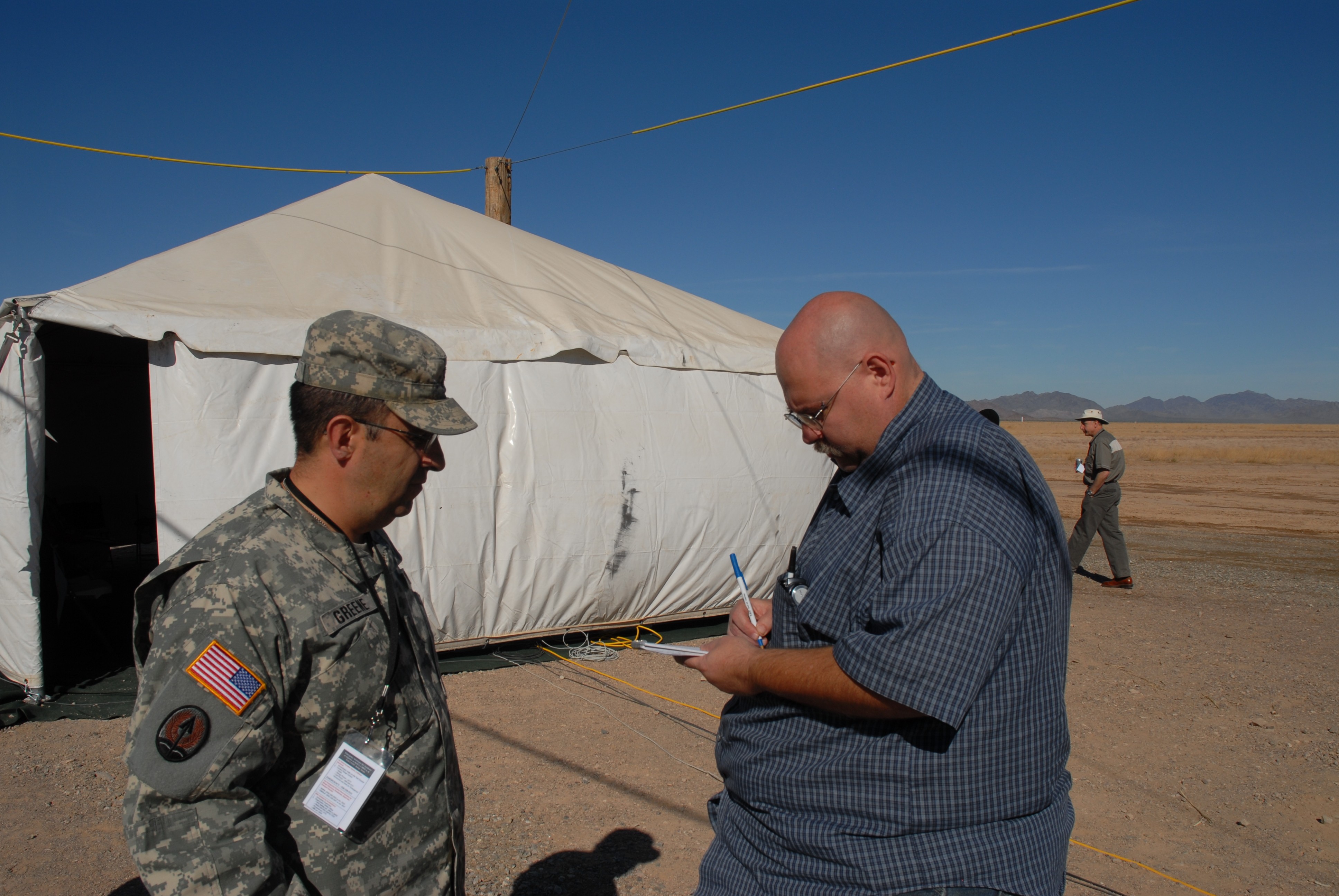
Yuma Proving Ground hosted the fifth biennial Precision Airdrop Technology Conference and Demonstration (PATCAD) the week of October 18th, and the turnout was the biggest yet. About 450 people from 17 different nations attended the event, necessitating a massive effort by YPG personnel to accommodate the visitors.
"There's not a soul in Air Delivery who didn't work PATCAD this year," said Grant Ware, director of the Aviation and Air Delivery Systems Division. "There is no other event like it in the world."
The effort was well worth it, though.
"It's exciting to show the whole array of cutting-edge technologies," said Robyn Tiaden, team leader in Air Delivery who was a main coordinator of the event. "It brings the entire airdrop community together in one place to exchange ideas."
The heavy involvement of air delivery division was supplemented by other YPG support staff, from visual information and electro-optical maintenance workers to people like NACCITEC's Isaac Russell, who emceed the conference.
"I'm a huge proponent of YPG being one team, so supporting this event was my pleasure," Russell said. "Precision airdrop saves lives, especially in a difficult environment like Afghanistan, and that is what we all are working for."
The offsite conference was sponsored by YPG contractor Trax International and was held in a cavernous banquet hall at the Quechan Resort, with a large static display of air drop equipment in an adjoining hall. The resort itself lacked the capacity to accommodate all of the conferees, who stayed in more than a dozen different local hotels and were transported to the conference and demonstrations by an impromptu transit system consisting of seven large busses. Though the viewing of nearly 250 different drops of cargo and personnel on an isolated YPG drop zone occupied most of PATCAD's demonstration schedule for the week, conferees assembled for a large dinner in the middle of the week to hear a keynote speech from Gen. Duncan McNabb, commander of the U.S. Transportation Command. With nearly 400 people in attendance, it was the largest dinner ever hosted by the resort.
"The people providing support behind the scenes are not professional event planners," Trax executive John Fargason told the conferees. "They are full-time employees of YPG who took time away from their jobs to make this event a success."
State of the Art
As the first PATCAD demonstration was being conducted on an isolated YPG drop zone the morning of September 11, 2001, the United States suffered the deadliest single attack ever inflicted within its borders by a foreign enemy. Al Qaeda, the terrorist group responsible, was based in Afghanistan, a war-torn, topographically daunting nation with few roads adequate to supply a large invading force. The few rudimentary and unmaintained roads are easy to hide improvised explosive devices within and low-flying helicopters are vulnerable to anti-aircraft fire. Parachuting materiel to Soldiers from high altitudes is a logical alternative, yet an errant drop that would be a minor annoyance to troops in flat, open terrain can be a harrowing ordeal on a landscape dominated by some of the world's highest mountains. Preventing this danger is a key motivation for developing guided parachute systems that use onboard computers and global positioning system technology to guide the payload as close to a target as possible.
"The technology has matured immensely since the first PATCAD," said Brian Bagdonovich, airdrop technology team leader at the U.S. Army Natick Soldier Research, Development, and Engineering Center, which oversees PATCAD. "We've gotten progressively more precise. The average distance the payloads have been landing away from the target is half as much as it was two years ago."
Virtually all of these systems have undergone extensive testing at YPG and Bagdonovich feels the precision aspect is nearly pat. He speculates that future research will focus on reducing cost and further easing the burden on ground troops. The difficulty of recovering a parachute in difficult terrain can be addressed by making modular systems in which small, expensive electronic components can be easily removed from bulky, inexpensive components of the system. These latter components could also be made disposable to keep them from falling into enemy hands and for increased stealth. For example, the parafoil can be made with materials that will rapidly degrade when exposed to water or sunlight.
The increased study of external factors like wind patterns has also helped with significant advances in precision.
"Mission planning is a big part of this program that has been overlooked," Bagdonovich said. "If the mission planners know the winds, they can use them to their advantage."
A prime means of doing this is to utilize multi-stage systems where a smaller, rounder parachute allows the payload to descend at such a speed that strong winds do not affect it. Once the payload reaches an altitude where wind speed has diminished, a larger parachute deploys.
All of these advances have or will be tested at YPG.
"YPG is where we do all our testing," Bagdonovich said with a smile. "You need plenty of room in case something goes wrong."
Yet YPG's size alone does not account for its elite standing in the air delivery community.
"There are other ranges that might have the air space to do it, but we're specifically designed to do it," said Ware. "We have the infrastructure and standard operating procedures to coordinate multiple sorties safely. We've been conducting air drop for decades and in doing that we've established good relationships with the entire community."
Demonstration
The demonstration site consisted of a set of bleachers under an awning and several large tents, in front of which were folding chairs, all overlooking an immensely desolate drop zone bordered by distant mountains. As each system was demonstrated, narrators addressed the crowd over a loudspeaker. With up to 14 sorties per day, each with multiple air drop passes, spectators did not want for parachute action. The event provided a prime opportunity for engineers and military officers from 17 different allied nations to discuss the state-of-the-art technology, both for inspiration and to avoid unnecessary duplication of existing ideas.
"Precision airdrop technology is a revolutionary change in military logistics," said Brig. Gen. Harold Greene, commander of U.S. Army Natick Soldier Systems Center, as he watched the demonstration. "Technologies on display here reduce the risk to both ground troops and air crews."
Among other superlatives, this year's PATCAD was the first to demonstrate drops from unmanned aerial systems. As in past years, a crowd pleasing attraction was Frank Deazley of Strong Enterprises who drove an all-terrain vehicle off the ramp of a C-130, landed safely near a target on the ground, then detached the large parachute and drove toward the spectators, where he was given a commander's coin by Gen. McNabb.
"It was a bit of a hard pull, but it went all right," Deazley said of his jump.
Mission Control
All drops conducted for PATCAD would not have been possible without careful coordination provided by mission controllers.
"Parachutes are a spectator sport," said Ware. "But if you're interested in data and information, mission control is the place to be."
More than 40 miles away from the drop zone, mission control was a dimly lit room where five test officers, two mission controllers, and a video operator seated at two rows of computers intently monitored all of the drops. There were five large screens on the wall: two showed radar information, three showed live footage of the drops from different angles, from the payload's extraction from the plane to the landing minutes later. All of the test officers use this room frequently, but the PATCAD demonstrations were much different than ordinary tests.
"The fact that there are multiple drops from multiple aircraft over a short time span with each drop having its own unique safety profile makes this far more intense," said Jeff Rogers, who served as the main PATCAD test officer in mission control. "Ordinarily we don't have hundreds of people watching and waiting for a drop, and a few of the systems being demonstrated have never been seen before."
Ten different aircraft were used to fly sorties. As Laguna Army Air Field is even further from the drop zone than mission control, it would be impossible to maintain the frenetic pace of one drop every 10 minutes if the aircraft were flying straight to the drop zone from the air field. Thus, as one aircraft made a drop, at least one other loitered in a holding pattern close by. To ensure the operation proceeded safely, Rogers and the other controllers were in constant communication with the pilots, personnel in a command tent located at the drop zone and safety observers around the perimeter of the drop zone who blocked entrance when a drop was in progress.
In addition to keeping this up for three days, the controllers also collected test data on some of the demonstration items ordinarily under test at YPG.
"It got pretty chaotic, but all went well," said Rogers. "We've received a great deal of positive feedback saying this was the best PATCAD yet."

Social Sharing